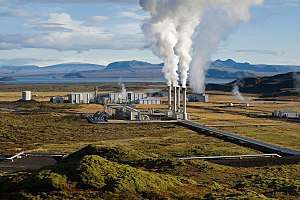Geothermal power in Canada
Canada has substantial potential for geothermal energy development.[1] To date, development has all been for heating applications. Canada has 103,523 direct use installations as of 2013.[2] There is currently no electricity being generated from geothermal sources in Canada although substantial potential exists in the Canadian Cordillera.[3] The most advanced project exists as a test geothermal-electrical site at the Mount Meager massif in British Columbia, where a 100 MW facility could be developed.[4] Potential for enhanced geothermal energy systems exists throughout Canada. There are six geothermal power and two direct use projects listed with the Canadian Geothermal Energy Association.
Canadian Geothermal Resources in Context The United States currently leads global development of geothermal power with 3,477 MWe of installed electrical power capacity, including 312 MWe added between 2010 and 2015.[5] Whereas, Canada has 0 MW online, however, the geology conducive to geothermal development does not arbitrarily end at the Canada–United States border. A number of states that share a border with Canada have significant geothermal capacity in development. It is estimated that Alaska has 95 MW in development, Idaho has 438-514 MW, Washington has 100 MW and even North Dakota has two small developments underway.[6]
At present, Canada remains the only major country in the Pacific Rim that is not producing electricity from its geothermal resources.[7] This is despite the fact that the colder it is outside, the more electricity a geothermal power plant can produce. This is because the larger the temperature differentials between the geothermal resource and the ambient air temperature, the more efficiently geothermal plants operate. This makes geothermal power ideal for cold northern countries.
In 2012, the Geological Survey of Canada issued a report entitled, the "Geothermal Energy Resource Potential of Canada (Open File 6914) ("The GSC Report").[8] The GSC Report concluded that "Canada’s in-place geothermal power exceeds one million times Canada’s current electrical consumption." Even if just a fraction of this energy can be put to use, it has the potential to significantly impact the Canadian electricity grid.
The GSC Report also notes that: The now-defunct National Geothermal Program (a Canadian government research program that ended in 1986) demonstrated that Canada has a geological environment favorable to geothermal development. This program defined high-temperature resources suitable for geothermal exploration and development, particularly in British Columbia, Yukon, and the Northwest Territories. Medium and low-temperature geothermal resources were also defined within sedimentary basins and abandoned mines throughout Canada. Pilot projects drilled at Meager Creek, British Columbia, and Regina, Saskatchewan further proved that geothermal power production in Canada is feasible. Now 25 years since the program ended advancements in technologies have further increased the economic potential of these geothermal resources.
Highest potential regions for electrical generation are located in British Columbia, Yukon, NWT and northern Alberta. Where suitably located these systems could be a connection to transmission lines, providing reliable and clean baseload power to Canadians.
See also
External links
- Canadian Geothermal Energy Association, .
- Canadian Geo Exchange Coalition, Geo-Exchange in Canada.
- On The Go Mimico, First Geo-Exchange Integrated Condo in Etobicoke, Ontario.
- Government of Canada, Geothermal Energy Resource Potential of Canada.
- Geothermal Canada, Geothermal Canada.
References
- ↑ Grasby, S.E.; et al. (2012). "Geothermal Energy Resource Potential of Canada" (PDF). Geological Survey of Canada.
- ↑ Raymond, J.; et al. (2015). "Direct Utilization of Geothermal Energy from Coast to Coast: a Review of Current Applications and Research in Canada" (PDF). Melbourne, Australia: Proceedings World Geothermal Congress, 19–25 April 2015.
- ↑ Grasby, S.E.; et al. (2012). "Geothermal Energy Resource Potential of Canada" (PDF). Geological Survey of Canada.
- ↑ Thompson, A. (2010). "Geothermal Development in Canada: Country Update" (PDF). Proceedings World Geothermal Congress 2010 Bali, Indonesia, 25–29 April 2010.
- ↑ Boyd, T.; et al. (2015). "The United States of America Country Update 2015" (PDF). Melbourne, Australia: Proceedings World Geothermal Congress, 19–25 April 2015.
- ↑ "2013 Annual US Geothermal Power Production and Development Report" (PDF). Geothermal Energy Association. Washington, D.C.: Geothermal Energy Association. 2013.
- ↑ Lund, J.W.; et al. (2015). "Worldwide Geothermal Energy Utilization 2015" (PDF). GRC Transactions, Vol. 39. pp. 79–91.
- ↑ Grasby, S.E.; et al. (2012). "Geothermal Energy Resource Potential of Canada" (PDF). Geological Survey of Canada.
